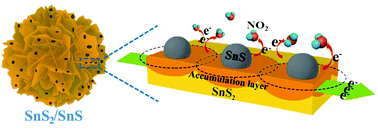SnS2/SnS p–n heterojunctions with an accumulation layer for ultrasensitive room-temperature NO2 detection†
Abstract
The unique features of SnS2 make it a sensitive material ideal for preparing high-performance nitrogen dioxide (NO2) gas sensors. However, sensors based on pristine tin disulfide (SnS2) fail to work at room temperature (RT) owing to their poor intrinsic conductivity and weak adsorptivity toward the target gas, thereby impeding their wide application. Herein, an ultrasensitive and fully recoverable room-temperature NO2 gas sensor based on SnS2/SnS p–n heterojunctions with an accumulation layer was fabricated. The amounts of SnS2/SnS heterojunctions can be effectively controlled by tuning the ratios of tin and sulfur precursors in the easy one-step solvothermal synthesis. Compared with pristine SnS2, the conductivity of SnS2/SnS heterostructures improved considerably. Such improvement was caused by the electron transfer from p-type SnS to n-type SnS2 because the Fermi level of SnS was higher than that of SnS2. The sensing response of optimized SnS2/SnS toward 4 ppm NO2 was 660% at room temperature, which was higher than most reported sensitivity values of other two-dimensional (2D) materials at room temperature. The superior sensing response of SnS2/SnS heterostructures was attributed to the enhanced electron transport and the increased adsorption sites caused by the SnS2/SnS p–n heterojunctions. Moreover, the SnS2/SnS sensor showed good selectivity and long-term stability. These achievements of SnS2/SnS heterostructured sensors make them highly desirable for practical applications.

- This article is part of the themed collection: 2019 Nanoscale HOT Article Collection


 Please wait while we load your content...
Please wait while we load your content...